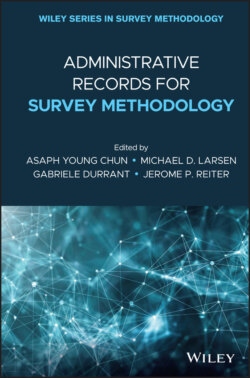Читать книгу Administrative Records for Survey Methodology - Группа авторов - Страница 60
Notes
Оглавление1 1 See www.census.gov/programs-surveys/cbp.html and https://www.census.gov/programs-surveys/ces.html.
2 2 In the United States, a combination of multiple lists and input by regional and subject matter experts is used to compile the frame for the Census of Population and Housing.
3 3 The latest version as of this writing is version 6.0.2 (U.S. Census Bureau 2015).
4 4 In much of the documentation for the SSB, the internal confidential files, harmonized across the SIPP panels and waves, and completed using the multiple imputation procedures that produced the four implicates at the root of the synthesis for confidentiality protection, are called the “Gold Standard” files. This nomenclature means that these are the files that would be provided to a researcher in the Census Bureau’s restricted access environment (FSRDC). Chapter 9 in this volume discusses linking methodologies.
5 5 Not all estimates are subject to suppression. Estimates such as employment are subject to suppression. Continuous dollar measures like payroll are not (Abowd et al. 2009, 2012).
6 6 Similar methods have been discussed for the QWI (Abowd et al. 2012; Gittings 2009), but not yet implemented.
7 7 The comparisons were computed using custom internal tabulations as well as published numbers, for two states (Illinois and Maryland). Only Maryland is reported here.
8 8 The disclosure avoidance assessment was run when first releasing the QWI, in 2003, and are reproduced here as they were presented to the Disclosure Review Board then. At the time, QWI were available for industry classifications according to the U.S. Department of Labor (DOL), 1987 definitions. Modern QWI are available for North American Industry Classification System (NAICS), 2012 definitions. The basic conclusion does not change.
9 9 Substate geography in all cases is a county, whereas the industry classification is the U.S. Department of Labor (DOL 1987).
10 10 The maximum semi-interquartile range for any SIC2-based variables is 0.0241, and for SIC3-based variables is 0.0244.
11 11 Data for Maryland. For additional variables and states, see Abowd et al. (2012). All histograms are weighted by Bkt. Industry classification is three-digit SIC (industry groups).
12 12 See https://www.census.gov/fsrdc (accessed on 15 December 2017).
13 13 The section draws on Weinberg et al. (2007) and Vilhuber (2013).
14 14 For an extensive history of the Canadian Research Data Center Network, see Currie and Fortin (2015).
